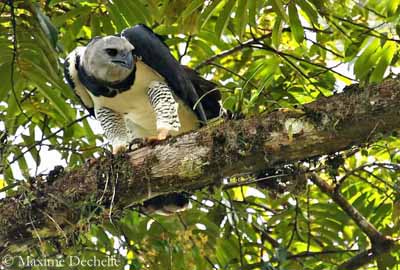
Fr: Harpie féroce
All : Harpyie
Esp : Arpía Mayor
Ital: Arpia americana
Nd: Harpij
Sd: Harpyja
Port: Gavião-real
Photographers :
Roger Ahlman
Pbase Galleries Peru and Ecuador & My bird pictures on IBC
Marc Chrétien
MURINUS
Maxime Dechelle
LEPAPARRAZO
Tom Merigan
Tom Merigan’s Photo Galleries
Text by Nicole Bouglouan
Sources :
HANDBOOK OF THE BIRDS OF THE WORLD Vol 2 by Josep del Hoyo-Andrew Elliot-Jordi Sargatal - Lynx Edicions - ISBN: 8487334156
A GUIDE TO THE BIRDS OF MEXICO AND NORTHERN CENTRAL AMERICA by Steve N. G. Howell, Sophie Webb - Oxford University Press - ISBN: 0198540124
A GUIDE TO THE BIRDS OF COLOMBIA by Steven L. Hilty and William L. Brown - Princeton University Press – ISBN 069108372X
PORTRAITS D’OISEAUX GUYANAIS - Groupe d'étude et de protection des oiseaux en Guyane (GEPOG) - Ibis rouge éditions - ISBN: 2844501842
The Peregrine Fund – World Centre for Birds of Prey
Wikipedia (Wikipedia, The Free Encyclopedia)
Harpy Eagle
Harpia harpyja
Accipitriforme Order – Accipitridae Family
BIOMETRICS :
Length: 90-105 cm
Wingspan: 200 cm
Weight: M: 4000-4800 g – F: 7600-9000 g
DESCRIPTION:
Only member of the genus “harpia”, the Harpy Eagle is a massive raptor, probably the largest and most powerful American eagle.

Both sexes are similar, but female is larger than male.
Adult has dark grey upperparts. The wings are relatively short, very broad and rounded. The long tail is barred white, with squared to slightly rounded tip.
Underparts are white, except the dark grey breast band. The thighs are white finely barred black. Underwing is barred black and white.
The head is grey, paler than upperparts, with conspicuous grey, erectile crest with feathers of different sizes. The massive hooked bill is dark grey with grey cere. Eyes are dark brown. Legs and feet are yellow. The powerful talons are equipped with very long black claws.
Immature needs 4-5 years to reach the adult plumage.
The first year plumage shows white head, underparts and thighs, and several tail bands.
The third year plumage shows grey head and black back, and faintly barred black thighs and underwing coverts. It lacks the blackish breast band.
The fourth year plumage is similar to adult with only 4-5 tail bars.

VOICE: SOUNDS BY XENO-CANTO
The Harpy Eagle adult utters loud, wailing, piping whistles “whee-whee-whee” or “wheeeeee”. We can also hear a weaker version of the same call. It also utters a quiet clucking “chuk-chuk”. But social and communication behaviour are not vocally loud.
HABITAT:
The Harpy Eagle frequents lowland tropical forest, usually below 800 metres of elevation. This large raptor favours undisturbed lowland forest, well away from human developments. This type of habitat provides them their favourite preys, monkeys, sloths and other arboreal and terrestrial mammals.
It often stays in the forest, but it hunts over the wooded areas and may perch in the canopy. This species is very secretive and rare, and it is relatively difficult to find it.

RANGE:
The Harpy Eagle occurs from S Mexico through Central America to Colombia, and eastwards through Venezuela to the Guianas, and southwards through E Bolivia and Brazil to extreme NE Argentina.
BEHAVIOUR:
The Harpy Eagle is a powerful raptor, able to hunt large vertebrates such as monkeys, sloths and other large arboreal mammals. It also takes terrestrial mammals, reptiles and birds (parrots and curassows).
It is a diurnal hunter, sitting quietly for long periods in the canopy. The attack is rapid. The bird pounces on the selected prey in short bursts of speed, and catches it with the long claws.
It often hunts at forest edges and in clearings, but also in the canopy. The larger preys are carried to fallen tree, to be torn to pieces or eaten.
The Harpy Eagle has keen hearing, helping to locate the preys. It is able to move amongst branches and vegetation, thanks to the short, broad wings.
Female which is larger than male, takes larger preys of up to 2, 5 to 9 kg, whereas the male takes preys between 0, 5 and 2, 3 kg. They often carry pieces of food to the nest.
The Harpy Eagle is very aggressive towards potential predators at nest-site, and may strike the intruder, even a human.
As other forest species, it does not perform any spectacular flight displays. This species is monogamous and mates for life.
It is sedentary within the wide range.

FLIGHT:
The Harpy Eagle is very agile when hunting through the forest, thanks to the relatively short wings. It is able to reach speeds of up to 80 km/hour.
This raptor rarely soars, or occasionally over the canopy. It often flies within the treetops with great agility, gliding and dodging through branches and foliage.
REPRODUCTION:
Breeding season and laying vary according to the range.
The Harpy Eagle nests in very large and tall trees of up to 50-70 metres of height.
This species builds a huge nest (about 150 cm of diameter), with large sticks and fresh leaves. The nest is situated up to 40-50 metres above the ground.

Female lays 1-2 eggs, but only one young seems to be raised. Incubation lasts 52 to 56 days, almost exclusively by female. The male brings food to the nest about once a week during the incubation period, and then, twice a week when the chick is hatched. It is covered in whitish down and fed by both parents for up to ten months or more. After fledging, it remains in the vicinity of the nest (within 100 metres) for at least one year. For this reason, adults car breed only every two or three years.

DIET:
The Harpy Eagle is carnivore. Preys are often large arboreal mammals such as monkeys, sloths, opossums and porcupines, but it also takes reptiles (serpents and iguanas), birds (parrots and curassows) and terrestrial mammals such as domestic pigs and young deer.
They favour the sloths which climb to treetops in the early morning to warm up. They catch them with the powerful talons while flying, and carry the prey to a fallen tree if too heavy.





